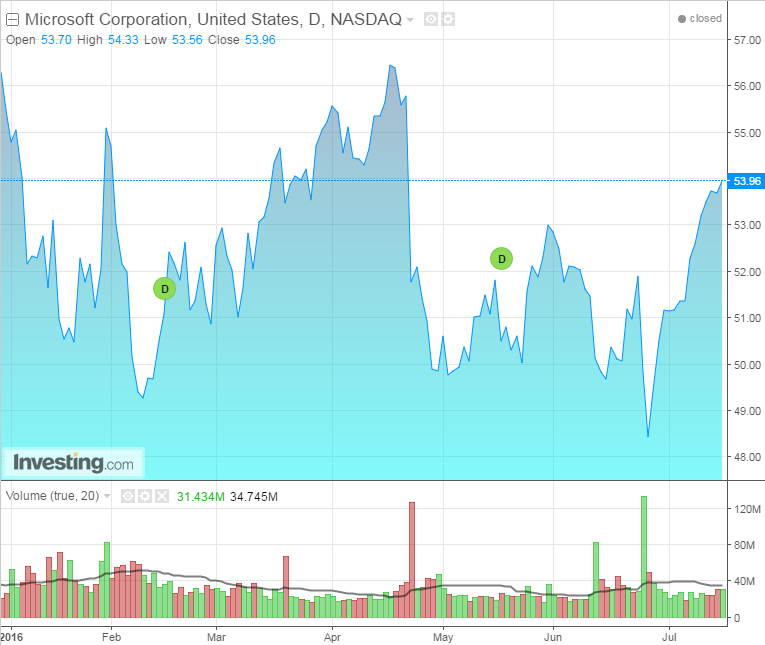
- All Instrument Types
- Indices
- Equities
- ETFs
- Funds
- Commodities
- Currencies
- Crypto
- Bonds
- Certificates
Please try another search

by Clement Thibault
Microsoft Corporation (NASDAQ:MSFT) reports Q4 earnings and revenue on Tuesday July 19, after the close.

1. Revenue and Earnings forecasts
Microsoft's forecast for the company's Q4 is $23.05B for revenue and $0.58 for EPS. Compared to last year, analysts are expecting a 2c drop in profitability, with a 5% rise in revenue. A drop below $0.60 EPS would be unfortunate for Microsoft, as it would halt the growth streak of the past four quarters, after a disappointing fiscal 2014 when EPS regressed about 7% on the year, with Q1 and Q3 regressing over 10%.
2. Acquisitions: the jury is still out
Two important events occurred since the last quarterly report on April 21. First, Microsoft purchased LinkedIn (NYSE:LNKD), the digital social network for professionals, for $26.2B. It's the largest acquisition ever for Microsoft, but the jury is still out on whether it was a smart move by the technology giant. It remains to be seen whether Microsoft will be able to leverage the purchase to benefit its core productivity business, which includes its Office suite and Windows products.
Last February, shares of LinkedIn fell by almost half—from $192 to $108—following LinkedIn's forecast of $3.6B revenue for 2016, well below Wall Street's expectation of $3.9B. While LNKD's 300M existing users are undeniably important potential customers for Microsoft's professional offerings, we'd still need to see more of Microsoft's business plan for this acquisition, as well as get a sense of how successful LinkedIn's integration will be in order to justify the hefty price tag.
Microsoft also took an impairment of $950 million as part of a restructuring of its mobile segment. This impairment is in addition to its $7.6B write-off a year ago, related to its September 2013 acquisition of Nokia (HE:NOKIA) for almost $10B, which failed to bring Microsoft's phone business up to par with Apple's (NASDAQ:AAPL) iOS or Alphabet's (NASDAQ:GOOGL) Android.
3. More personal computing
As a result of its 2015 corporate restructuring for all things not related to the Office suite or the Cloud business, MSFT created the MPC division, which stands for 'More Personal Computing'. This disparate division encompasses everything from hardware—such as phones and tablets—to software such as Windows 10, Xbox and Bing. It accounts for 43% of revenues but only 23% of the company's operating income.
According to BMO Capital Markets analysts, this division will be responsible for most—if not all—of the operating growth for Microsoft this quarter. Unfortunately, most of the growth within that division appears to have come from cutting operational expenditures. The bottom line then isn't all that attractive: while the numbers for Microsoft's fiscal Q4 could be good, investors need to lower their future expectations since potential cost cutting moves are finite.
4. Cloud Computing as rainmaker?
Cloud Computing, or the "Intelligent Cloud" as designated by Microsoft, is supposed to be the company's growth engine for the future. Microsoft announced a target of $20 billion in annual revenue by 2018, which might just happen. Azure, Microsoft's cloud platform, has seen its revenue grow by 120% year-over-year in fiscal Q3 '16.
Though Microsoft is still playing catch up to market leader Amazon (NASDAQ:AMZN), with Azure bringing in an estimated 600M quarterly compared to Amazon Web Services' $2.5B, the importance of cloud computing in general is growing, and Microsoft is positioned to reap a good part of the benefits. Revenue numbers suggest it is currently number two in the industry behind Amazon but ahead of Google and IBM (NYSE:IBM).
5. Strong dollar
As always, a strong dollar is detrimental to companies that bring in significant revenue from overseas. The dollar hasn't lost a step this past quarter, what with Brexit and European bank turmoil affecting the euro and adding risk to the market equation. Up until now the backwash hasn't been drastic, but it's still something to keep in mind when considering the overall the numbers.
Conclusion
Microsoft is no longer an exciting new venture. Indeed, it's now a mature business and should be evaluated as such. It would wrong to expect it to revolutionize the world again.
While it's losing traditional revenue from physical server products, it's making a strong effort to replace that revenue via new resources and technology, such as the cloud. That's good because Microsoft's core business doesn't seem to be going anywhere significant.
It would be reasonable to expect Microsoft to resume EPS and revenue growth after a period of adaptation to its changing business environment. After a rough, stagnant patch, we believe it will break through and resume revenue and EPS growth of 5-7% percent a year. We anticipate the share price will likely follow.





